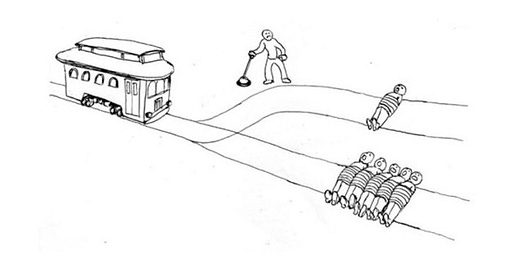#18: Oppenheimer and the Trolley problem
Why it's not morally fair to judge the past without context
Hey friends,
In this edition, I will talk about:
my intention of building another online course
Oppenheimer and the Trolley Problem
3 posts I liked
a productivity YouTube video I recommend
top myths about Software Project Managers
1/ My next course
I haven’t done anything spectacular this week, as I was busy with work and went to CrossFit or for a run in the evenings.
Last Sunday I ran my first 10K in a couple of years, and I plan to run 12.5 this weekend. So, the plan for the half-marathon is still standing.
I decided to create a new course, more focused on my experience, in the area of Software Project Management.
I am not sure what the course's focus will be at the moment, but I will build it in public so I will ask you and people in my audience on Twitter and LinkedIn what they are more interested in.
The main thing I’m struggling with is who my audience should be.
software developers who want to become PMs
newly-appointed PMs who want to be better
non-programmers who want to become tech PMs
established PMs who want to take it to the next level
I don’t have a deadline for this, as it might be my flagship course, so I want to take my time building it.
To help me in this endeavor, I enrolled in the August Build in Public cohort with Kevon Cheung.
You can do it too by accessing this link (no affiliate).
https://buildinpublicmastery.com/
What does “build in public” mean? It takes the concept of the “lean startup” and applies it to info products.
Ok, that’s also confusing; I agree.
Mainly, a lot of people spend months or years building courses or writing books. Only to launch them and hear crickets.
So much time lost building a product no one cares about.
On the other hand, if you build in public, meaning you ask your audience for their opinion and feedback, you can validate your idea and deliver what your future buyers want to see.
It’s not a bulletproof method to build a successful product, but it sure helps. At least I hope it does.
And rest assured, I will involve you in the process as well.
Just stay tuned ;)
2) Oppenheimer and the Trolley problem
I saw Oppenheimer last week, and it is a very good movie. I would not say it’s great; I think it should have focused on only one of the important aspects of his life, probably the Manhattan Project.
By going back and forth in time, I feel it didn’t fully explore the enormities of what it meant to build the first atomic bomb.
But the movie made me remember the Trolley problem.
The trolley problem is a famous thought experiment in ethics. It presents a scenario where a runaway trolley is barreling down the railway tracks. Ahead, there are five people on the tracks who will be killed if the trolley continues on its current path.
However, the person driving the trolley sees that there is a spur of track that leads off to the left. On this side track, there is one person.
The driver has the option to hit a switch and divert the trolley onto the side track, killing one person but sparing the five others.
The question this scenario poses is whether it would be ethically justifiable for the driver to hit the switch and divert the trolley to the side track.
Doing so would mean directly causing the death of one person, but it would save five others.
However, not touching the switch means doing nothing, as the trolley kills the five people ahead.
This basic version highlights a dilemma between active intervention versus passive inaction and utilitarian arguments of the greatest good for the greatest number versus the moral status of individual lives.
If you are thinking about what you would do, just remember that there is no consensus on what the “right” choice would be.
There are several variations of this that might change your decision.
you don’t get to pull a lever but you can push someone in front of the tracks to stop the trolley
the person on the other line is someone who is dear to you
I can imagine that Oppenheimer and the other participants in the Manhattan Project faced a similar decision when developing the atomic bomb.
They knew the bombs they were creating could potentially kill tens or hundreds of thousands of civilians if used against populated cities.
However, military projections estimated that invading and occupying Japan could cost well over 1 million American casualties, in addition to enormous Japanese military and civilian deaths.
By using the atomic bombs to end the war quickly, project leaders believed they were choosing the option that would result in the fewest lives lost overall. Just as the trolley problem presents diverting the trolley as killing one to save five, dropping atomic bombs on Hiroshima and Nagasaki was seen as a means to sacrifice tens of thousands to save millions.
Of course, the trolley problem is an abstract philosophical scenario, while the Manhattan Project involved real human lives. But the underlying question of weighing moral costs remains essentially the same: how do we justify prioritizing some lives over others to minimize loss of life?
Both situations force difficult choices between horrible options.
The Manhattan Project leaders opted for the "utilitarian" choice, just as those who argued to divert the trolley in the thought experiment did.
Their decision and its consequences remain hotly debated to this day.
And there is another aspect to consider: building the atomic bomb cannot be considered in a vacuum, like a trolley problem.
In the long term, it can cause, as it did, global turmoil and constant fear of nuclear war, which could be the war to end all things.
It’s like opening a Pandora's Box that you can no longer close. Knowing that there is this force in the world is very unsettling.
On the other hand, if the Americans hadn't done it first, someone else would have.
And they did; that’s why there are several countries in the world that now have nuclear weapons.
As a conclusion, there is no way to know how the world would have looked if the Manhattan Project had not been a success.
Secondly, and more importantly, in my opinion, it’s the uselessness of morally judging the past with present eyes.
The only fair way to judge a situation is by looking at the whole context in which that scenario took place.
3/ 3 Posts I liked
3 tweets or LinkedIn posts that made me think, educated me or amused me over the last week
Should you always involve the group in making decisions?
Self-explanatory (click the photo to see them all):
Some basic nutrition rules:
4/ Recommended video: which productivity tricks really work?
Ali Abdaal is one of my favorite YouTubers. Long story short, he was a medical student who created a YouTube channel about how to get into med school and then started talking about how to be productive as a medical student.
4.5 million subscribers later, Ali abandoned medical school for a job as a full-time creator.
He will also launch a productivity book in the next few weeks.
I recommend this video because it’s a short masterclass on the little things and strategies you can apply to your life today to become more productive.
I would say this is 80/20, meaning that by applying these strategies only, you will be more productive than 80% of the people.
5/ My own favorite piece of content
This Twitter thread about myths and facts about Software Project managers
Ever wondered what it's like to lead a team of developers?
10 Myths and Facts about Software Project Managers:
❌ Myth #1: The Project Manager is the boss.
✅ Fact: Most companies have a matrix structure and people are not necessarily subordinates of the PM.
The PM could only be responsible for the project, not the individuals.
❌ Myth #2: Programming experience is mandatory.
✅ Fact: Some of the best Tech Leaders I know never programmed for a living.
I also have a QA background, and even though I have programmed before, I was never a formal Developer.
Different jobs, different skill sets.
❌ Myth #3: They control everything.
✅ Fact: Project Managers facilitate and guide the project.
Success comes from collaboration and communication.
Being a control freak will hurt your project and your team.
❌ Myth #4: They need to rely on fixed processes.
✅ Fact: An adaptable attitude allows project managers to effectively navigate changes and unexpected challenges.
Processes and frameworks are there only to guide you toward results.
❌ Myth #5: They spend all their time in meetings.
✅ Fact: Meetings are a big aspect of management but good PMs only use them when they are really needed.
Today's methodologies rely a lot on asynchronous tools and status being visible in centralized locations.
❌ Myth #6: They are born with leadership qualities.
✅ Fact: Like almost anything in the world, project management and leadership are things you can learn.
You just need to have the mindset and the discipline to try it.
❌ Myth #7: They are unnecessary; teams can manage themselves.
✅ Fact: While self-organizing teams are important, project managers provide guidance, remove obstacles, and ensure alignment with higher goals.
Teams that operate without a PM will descend into chaos.
❌ Myth #8: They guarantee success.
✅ Fact: Success depends on multiple factors, including team skills, resource availability, or stakeholder collaboration.
Not to mention that sometimes it's about external factors beyond the project manager's control.
❌ Myth #9: The right planning software will save the project.
✅ Fact: No software will replace situations like:
• lack of communication
• poor risk management
• bad planning
People > tools.
❌ Myth #10: Avoid conflict at all costs
✅ Fact: Sometimes conflict is necessary to move forward and a team who never contradicts you or with each other might be a team that doesn't care.
Create a safe space for people to speak up about their ideas.
Thank you for reading, and let me know if you liked something in particular in this newsletter.
Until next time,
Leo
P.S.: If you would like to read my content on a daily basis, don’t forget to follow me on Twitter and Linkedin.
P.S. 2: If you want to take your Productivity to the next level, check out my extensive Productivity course that can accelerate your career.







